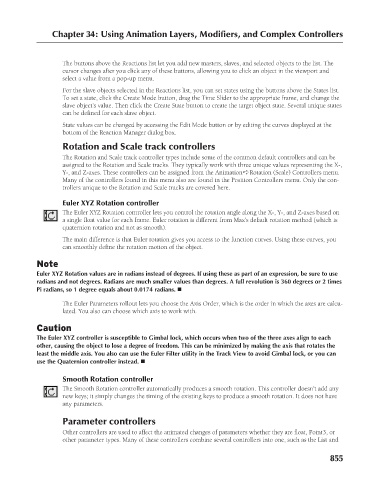Page 903 - Kitab3DsMax
P. 903
Chapter 34: Using Animation Layers, Modifiers, and Complex Controllers
The buttons above the Reactions list let you add new masters, slaves, and selected objects to the list. The
cursor changes after you click any of these buttons, allowing you to click an object in the viewport and
select a value from a pop-up menu.
For the slave objects selected in the Reactions list, you can set states using the buttons above the States list.
To set a state, click the Create Mode button, drag the Time Slider to the appropriate frame, and change the
slave object’s value. Then click the Create State button to create the target object state. Several unique states
can be defined for each slave object.
State values can be changed by accessing the Edit Mode button or by editing the curves displayed at the
bottom of the Reaction Manager dialog box.
Rotation and Scale track controllers
The Rotation and Scale track controller types include some of the common default controllers and can be
assigned to the Rotation and Scale tracks. They typically work with three unique values representing the X-,
Y-, and Z-axes. These controllers can be assigned from the Animation ➪ Rotation (Scale) Controllers menu.
Many of the controllers found in this menu also are found in the Position Controllers menu. Only the con-
trollers unique to the Rotation and Scale tracks are covered here.
Euler XYZ Rotation controller
The Euler XYZ Rotation controller lets you control the rotation angle along the X-, Y-, and Z-axes based on
a single float value for each frame. Euler rotation is different from Max’s default rotation method (which is
quaternion rotation and not as smooth).
The main difference is that Euler rotation gives you access to the function curves. Using these curves, you
can smoothly define the rotation motion of the object.
Note
Euler XYZ Rotation values are in radians instead of degrees. If using these as part of an expression, be sure to use
radians and not degrees. Radians are much smaller values than degrees. A full revolution is 360 degrees or 2 times
Pi radians, so 1 degree equals about 0.0174 radians. n
The Euler Parameters rollout lets you choose the Axis Order, which is the order in which the axes are calcu-
lated. You also can choose which axis to work with.
Caution
The Euler XYZ controller is susceptible to Gimbal lock, which occurs when two of the three axes align to each
other, causing the object to lose a degree of freedom. This can be minimized by making the axis that rotates the
least the middle axis. You also can use the Euler Filter utility in the Track View to avoid Gimbal lock, or you can
use the Quaternion controller instead. n
Smooth Rotation controller
The Smooth Rotation controller automatically produces a smooth rotation. This controller doesn’t add any
new keys; it simply changes the timing of the existing keys to produce a smooth rotation. It does not have
any parameters.
Parameter controllers
Other controllers are used to affect the animated changes of parameters whether they are float, Point3, or
other parameter types. Many of these controllers combine several controllers into one, such as the List and
855

